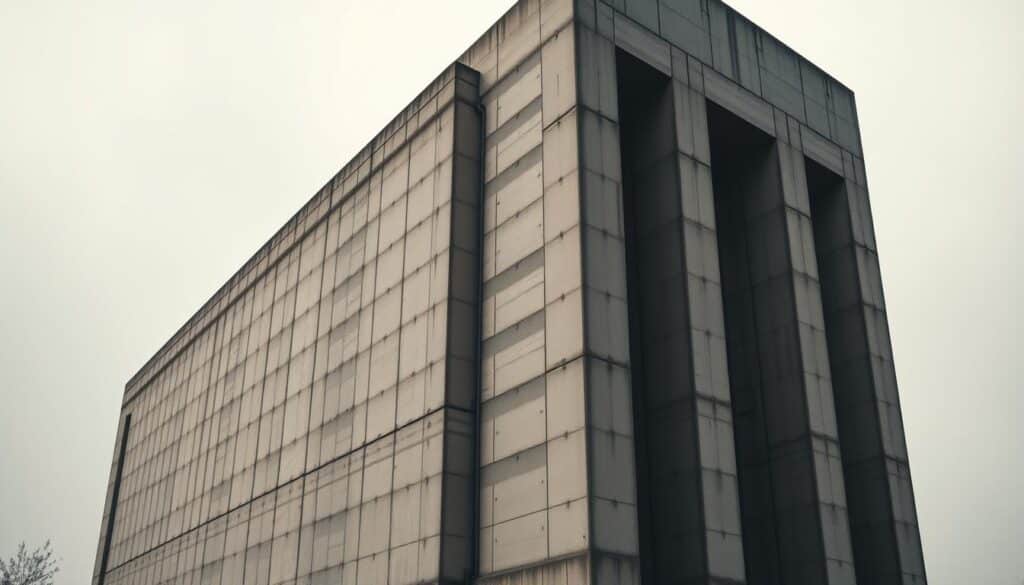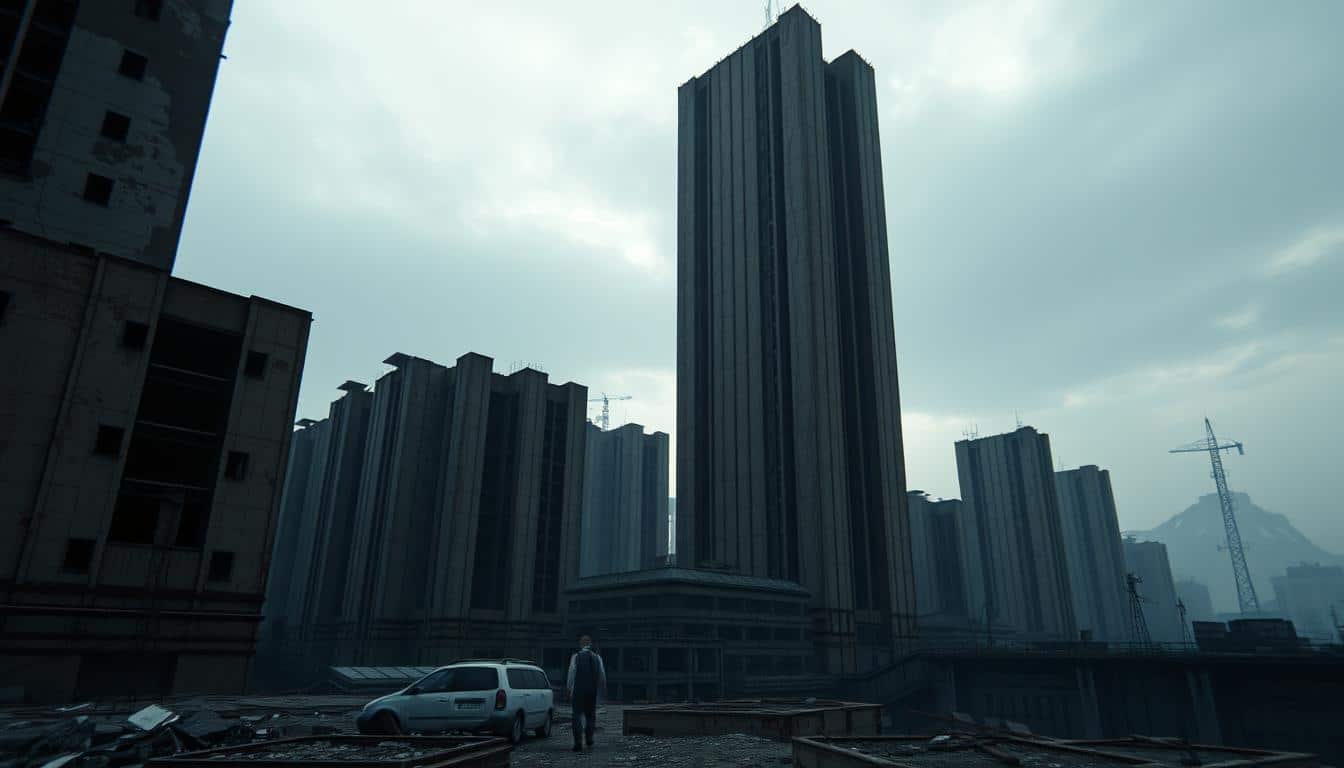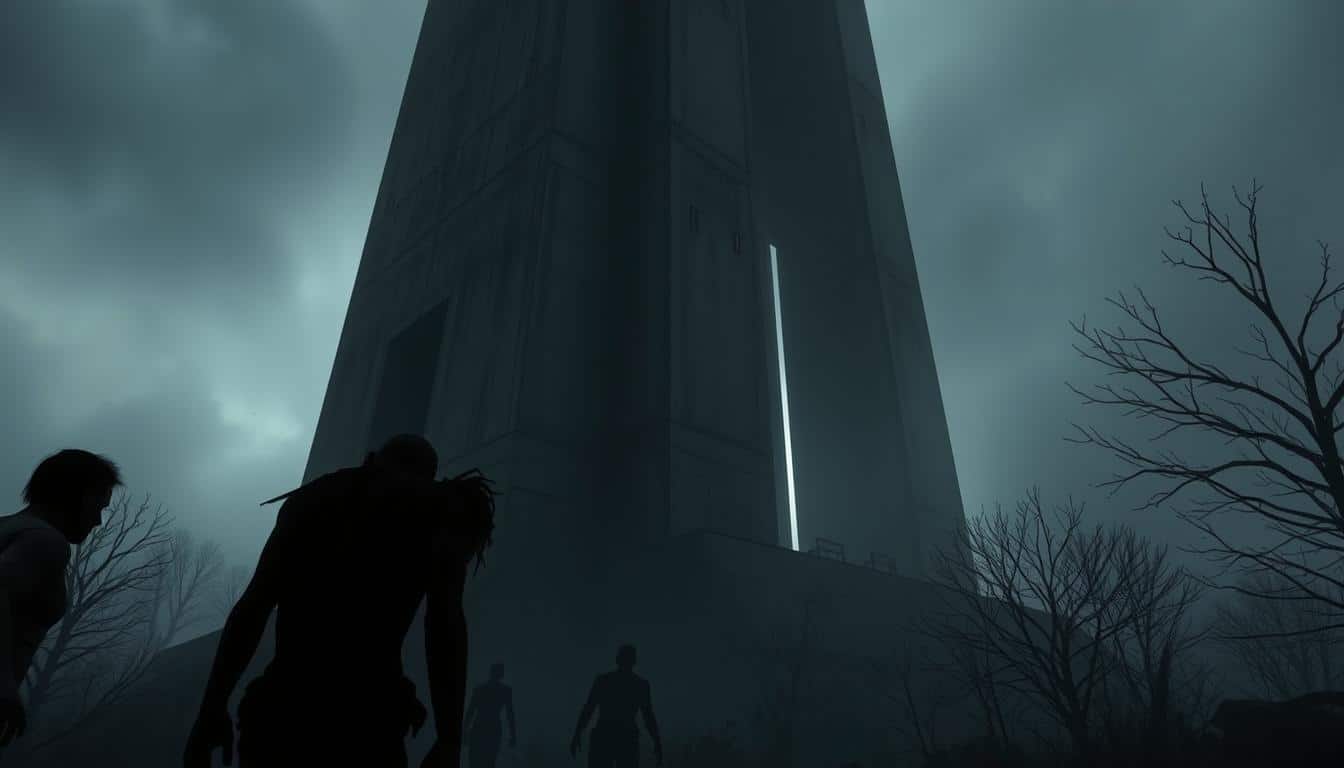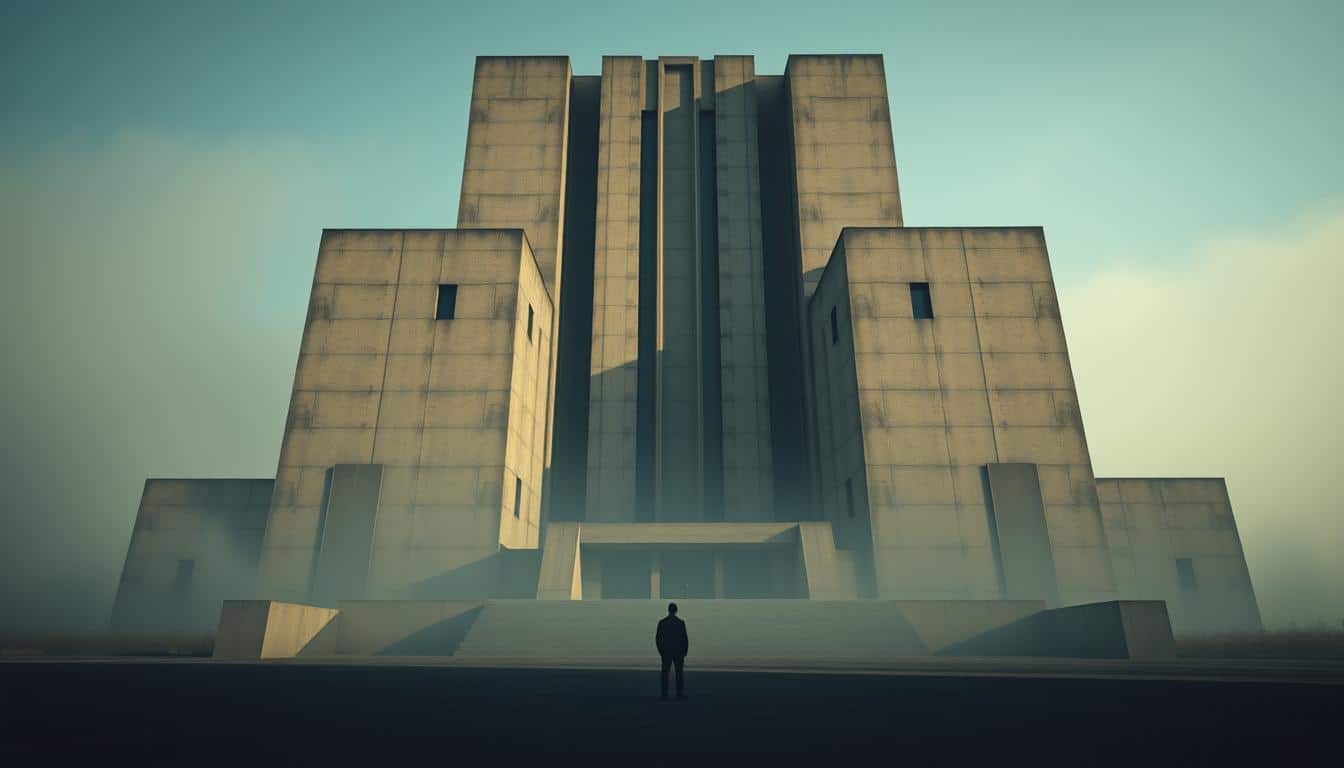The unique look of Soviet Brutalism is now a hot trend in game design. This article shows how to use its stark, raw style to make game levels more engaging. We’ll explore how knowing its history and features can help create unforgettable settings.
Tips from experts will guide you. They’ll show how to use its bold walls and textures. These aren’t just for looks—they make gameplay more exciting.
Understanding Soviet Brutalism and Its Aesthetic
Soviet Brutalism is more than a style; it’s a glimpse into history. Born from historical events, this movement favors raw materials and function. Its characteristics and origins shed light on urban and communal life in post-war times.
Characteristics of Brutalist Architecture
Key traits of Soviet Brutalism are:
- Extensive use of raw concrete, resulting in a sturdy, unadorned look.
- Simple, geometric forms that convey a sense of boldness and strength.
- An emphasis on functionality that prioritizes practical use over decorative embellishments.
This style’s honesty and purpose turn buildings into symbols of ideology. It’s about more than looks; it speaks to ideals of equality and accessibility. Brutalist buildings are known for their lasting presence and goal-driven design.
Historical Context and Influence
After World War II, a housing crisis led to Soviet Brutalism’s rise. It flourished in socialist countries, pushing for communal living solutions. The Barbican Estate in London, although not in the Soviet Union, mirrors this movement’s effects on urban spaces in Eastern Europe.

Soviet Brutalism’s distinct designs fostered community spirit and interaction. Its legacy endures, influencing modern architecture and city planning deeply. This architectural style marks a significant era, reflecting societal values of its time.
The Role of Functionality in Game Design
In Game Design, Soviet Brutalism’s principles help improve playability and user experience. By choosing Functionality and Utility over fancy designs, creators make worlds that are useful. This leads to games where playing feels natural.
Emphasizing Utility over Ornamentation
A minimalist approach makes for smoother gameplay. Designers use simple shapes and clear paths to help players reach goals. By focusing on what’s useful, game spaces work better, letting players dive deeper into the game. This way, the game stays interesting and fun.
Creating Functional Game Spaces
Designing game areas means thinking about how players move and interact. Making spaces that help with the game’s goals improves gameplay. For example, a spot to hide and plan your next move adds depth. Smart design makes games more absorbing and lets players make game-changing decisions.
Soviet Brutalism Integration in Game Level Design
Soviet Brutalism gives game levels a special look with its raw materials and textures. By using this style, designers can make game worlds that really pull players in. They use solid concrete and bare structures to make everything feel more real. This helps players get totally lost in the game.
Implementing Raw Materials and Textures
Using real materials is key to making game levels feel genuine. Textures should be rough, like the true brutalist style. Here are some tips:
- Incorporating concrete textures to create a stark atmosphere.
- Utilizing rusted metal and vibrantly unfinished surfaces for a more gritty and realistic look.
- Integrating details that emphasize the tactile nature of materials, inviting players to explore their environments.
Crafting Modular and Geometric Structures
Adding modular structures that reflect Soviet Brutalism is another way to enhance game levels. These structures bring a mix of repetition and uniqueness to gameplay. Keep these points in mind:
- Designing modular components that adhere to the geometric principles of brutalist architecture.
- Creating sightlines that facilitate tactical gameplay while maintaining player interest.
- Encouraging exploration through strategically positioned vertices and angles within the layout.
Designing for Interaction and Community
Brutalist architecture brings new ways to boost interaction and community in game levels. By making spaces that invite exploration, developers can create deep social experiences. These experiences stick with players, making the game more memorable.
Encouraging Player Interaction within Spaces
Designing game areas for player interaction makes the game more fun. Open spots with clear landmarks help players work together or compete. These areas become spots where players meet, feeling part of something bigger.
Paths and interactive elements near these landmarks promote teamwork. This setup leads to great social moments among players.
Creating Environments that Foster Social Engagement
To increase social connections, it’s key to create spaces that do more than just allow players to interact. Big open spaces with lots of room make perfect spots for players to come together. Adding places to sit and things to interact with makes players feel more at home in these virtual spaces.
This design approach helps players make friendships, teams, and unforgettable moments. It makes the game’s design shine even brighter.
Lighting and Atmosphere in Brutalist Game Environments
The way a game feels can greatly depend on its lighting and design. In Brutalist games, sunlight plays a key role, shaping how players feel. The right light can make us feel connected to the game’s world, especially in Brutalism’s bold scenery.
Using Natural Light to Enhance Mood
Sunlight doesn’t just help us see; it affects how we feel. By adding windows, the game can show the sun’s movement, changing the scene’s mood. It makes the game look real and highlights Brutalism’s unique style. As day turns to night, players feel the passage of time, adding depth to the game.
Color Palettes that Reflect Brutalist Ideals
Colors matter a lot in Brutalist games. Designers pick muted and simple colors that fit Brutalism’s industrial vibe. These colors, paired with the game’s lighting, can make us feel calm or tense. The chosen hues match the game’s story, pulling players deeper into the adventure.
Create Unique Combat Scenarios with Brutalist Settings
Designing combat scenarios in brutalist environments is a cool chance to use architecture smartly. These places have big, bold shapes and bare materials. This sets up a special kind of fight that’s more challenging. Players get way into their surroundings, using the buildings to sneak past or face their enemies head-on.
Using Environment for Tactical Advantage
Brutalist spaces are great for creative fight plans. They have:
- Strategically placed cover points
- Open sightlines for ambushes
- Multiple entry and exit routes
This setup makes players think hard about where they stand. By adding these features, game makers can create fights that are all about smart decisions and strategies. When players use the setting well, they can win in cool, unforgettable ways.
Cascading Verticality in Gameplay Challenges
Brutalist buildings have a way of adding layers to fights, making strategy even more crucial. Challenges of going vertical might include:
- Using high spots for better views
- Making spots for sniping or surprises
- Adding ramps and edges for quick getaways
This vertical layering doesn’t just make fights better. It also makes players want to see and use the space in new ways. When game designers blend the setting with the game goals, they create deep experiences. These mixes of strategy and action stick with players.
Player Experience and Emotional Engagement
Game design heavily relies on its architecture to shape how players feel and engage. Immersive storytelling takes center stage through carefully thought-out designs. This makes the environment more than just scenery.
It turns into a powerful tool for storytelling, where the surroundings tell their own tales. This deep connection helps players dive into a world tailor-made to evoke strong feelings.
Crafting Immersive Storytelling Through Architecture
Storytelling through architecture can greatly improve how players experience a game. Designers have several strategies to enhance this:
- Utilizing distinct structural designs that reflect the game’s theme and setting.
- Creating spaces that encourage exploration and interaction, unveiling layers of narrative through environmental details.
- Employing lighting and sound elements to enhance the mood and deepen emotional engagement.
By focusing on these elements, games can create strong emotional responses. Emotional engagement grows when players feel part of a living, responsive world. This shows the powerful link between architecture and storytelling.
Exploring Soviet Influences in Modern Game Design
Soviet influence shapes today’s game design, especially through Brutalist aesthetics. This style enters games, making settings that mirror history and social ideas. Games today show how creators use these influences in their designs.
Examples of Games Inspired by Soviet Brutalism
- Stalker: Shadow of Chernobyl – This game offers an eerie, absorbing world. It has desolate scenes and left-behind buildings that show Soviet architecture. Players explore what’s left of a once-busy civilization.
- Metro 2033 – It’s a key example of using tight spaces to reflect Soviet-era worries and views. Its underground world shows the bare, practical look of Brutalism.
- Wolfenstein II: The New Colossus – This game brings in Soviet architecture by showing an alternate history. It features big buildings that convey control and oppression themes.
These games focus on practical design and add insight into cultural stories. They blend raw materials and industry ideas, showing how today’s game design learns from the past.
Balancing Chaos and Order in Level Design
Integrating Soviet Brutalism into game designs is a tough task for designers. This style mixes chaos and order, so finding the perfect balance is key. Doing it well improves the gaming experience. It lets players explore worlds inspired by Brutalist architecture while guiding them clearly.
Finding Harmony in Brutalist Chaos
Brutalist buildings can seem chaotic because of their stark, unusual shapes. But, if designed right, they offer a sense of order that helps players move and interact smoothly. The trick to hitting this sweet spot is to use clear cues and pathways. This leads players through the game’s complex designs.
- Incorporate clear sightlines to minimize confusion.
- Use contrasting color palettes to highlight focal areas.
- Design modular elements that invite exploration while maintaining structure.
By mixing chaos and order smartly, the game becomes more engaging and visually exciting. This balance makes the game not just good to look at but also fun to play. Players get lost in the world, fully engaged in what they’re doing.
Conclusion
Soviet Brutalism offers a special view for game designers to make memorable and immersive game worlds. This style’s focus on function over looks helps create spaces where the game play matters most. This way, games can offer new experiences that truly connect with players.
It’s key to engage players deeply in these well-thought-out spaces. Game developers can tell stories through buildings, making game worlds that challenge and welcome players at the same time. Using Soviet Brutalism’s ideas can spark new creativity in virtual space design.
As game design grows, using Soviet Brutalism’s features is an exciting path. It mixes order and chaos in a way that draws players in. Developers can create unique experiences that push gaming to new levels.



